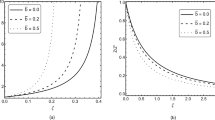Abstract
The instability of a free surface of aluminum after passage of two shocks that follow one after the other at a certain time interval is studied numerically. The first shock is rather strong (the postshock pressure is about 75 GPa). It is shown that if at the moment when the second shock arrives at the free surface, the perturbation evolution is nonlinear, then, in contrast to the linear stage, the change in the growth rate of the amplitude depends weakly on the wavelength of the initial perturbation. A formula is proposed which describes the effect of the second shock on the amplitude growth rate and in which the main structure of Richtmyer's formula is preserved. It is demonstrated that the parameters of the second shock that ensure freezing of the instability can be determined using only the growth rate of the amplitude.
Similar content being viewed by others
References
R. D. Richtmyer, “Taylor instability in shock acceleration of compressible fluids,”Comm. Pure Appl. Math.,13, No. 2, 297–319 (1960).
E. E. Meshkov, “Instability of an interface between two gases accelerated by a shock,”Izv. Akad. Nauk SSSR, Mekh. Zhidk. Gaza, No. 5, 151–157 (1969).
K. A. Meyer and P. J. Blewett, “Numerical investigation of the stability of a shock-accelerated interface between two fluids,”Phys. Fluids,15, No. 5, 753–759 (1972).
N. N. Anuchina, S. M. Bakhrakh, A. V. Zabrodin, et al., “Hydrodynamic instability of an interface between two media,” in:Investigation of Hydrodynamic Stability Using Computers [in Russian], Inst. of Appl. Math., USSR Acad. of Sci., Moscow (1981), pp. 108–162.
A. N. Aleshin, V. E. Lazareva, S. G. Zaitsev, et al., “Linear, nonlinear, and intermediate stages of development of Richtmyer-Meshkov instability,”Dokl. Akad. Nauk SSSR,310, No. 5, 1105–1108 (1990).
V. E. Neuvazhaev, “Development of turbulent mixing due to Richtmyer-Meshkov instability,”Mat. Model.,3, No. 7, 10–28 (1991).
I. G. Lebo, V. V. Nikishin, V. B. Rozanov, and V. F. Tishkin, “On the influence of boundary conditions on the development of contact surface instability due to arrival of a shock,”Krat. Soobshch. Fiz., Nos. 1/2, 48–57 (1997).
G. Dimonte, C. E. Frerking, M. Schneider, and B. Remington, “Richtmyer-Meshkov instability with strong radiatively driven shocks,”Phys. Plasmas,3, No. 2, 614–630 (1996).
K. O. Mekaélian, “Richtmyer-Meshkov instabilities in stratified fluids,”Phys. Rev. A,31, No. 1, 410–419 (1985).
A. A. Charakhch'an, “Stability of shaped-charge jets generated by pulsed action on conical targets,”Prikl. Mekh. Tekh. Fiz.,38, No. 3, 10–13 (1997).
V. E. Meshkov, “Results of experimental studies of gravitational instability on an interface between media with different densities,” in:Investigation of Hydrodynamical Stability Using Computers [in Russian], Inst. of Appl. Math., USSR Acad. of Sci., Moscow (1981), pp. 162–190.
A. V. Bushman, G. I. Kanel', A. L. Ni, and V. E. Fortov,Thermophysics and Dynamics of Intense Impulsive Impacts [in Russian], Inst for Chem. Phys., Chernogolovka (1988).
Ya. B. Zel'dovich and Yu. P. Raizer,Physics of Shock Waves and High-Temperature Hydrodynamic Phenomena, Academic Press, New York (1967).
S. A. Ivanenko and A. A. Charakhch'an, “Curvilinear meshes with convex quadrangular cells,”Zh. Vychisl. Mat. Mat. Fiz.,28, No. 4, 503–514 (1988).
A. A. Charakhch'an, “Elliptic generator of meshes based on quasi-one-dimensional meshes,”Zh. Vychisl. Mat. Mat. Fiz.,39, No. 5, 832–837 (1999).
D. L. Youngs, “Modeling turbulent mixing by Rayleigh-Taylor instabilities,”Physica D,37, Nos. 1/3 270–287 (1989).
Yu. A. Kucherenko, V. E. Neuvazhaev, and A. P. Pylaev, “Behavior of a gravitational mixing region under conditions leading to separation,”Dokl. Ross. Akad. Nauk,334, No. 4, 445–448 (1994).
Additional information
Computing Center, Russian Academy of Sciences, Moscow 117967. Translated from Prikladnaya Mekhanika i Tekhnicheskaya Fizika, Vol. 41, No. 1, pp. 28–37, January–February, 2000.
Rights and permissions
About this article
Cite this article
Charakhch'an, A.A. Richtmyer-Meshkov instability of an interface between two media due to passage of two successive shocks. J Appl Mech Tech Phys 41, 23–31 (2000). https://doi.org/10.1007/BF02465232
Received:
Issue Date:
DOI: https://doi.org/10.1007/BF02465232




